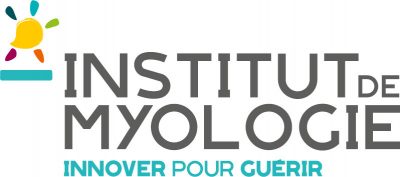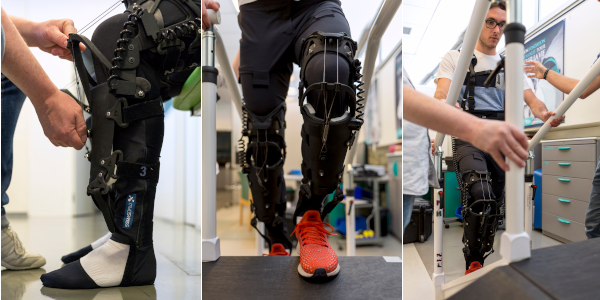 The rare neuromuscular diseases are characterised, in particular, by a progressive loss of muscle strength. As a result, getting up, sitting down or going up stairs can quickly become difficult. This is why the Institute of Myology, a centre of expertise in the science and medicine of the muscle, has just launched two studies, whose objective is to assess the efficacy of two robotic exoskeletons to compensate for muscle weakness in the lower limbs, among 80 patients with neuromuscular diseases.
The rare neuromuscular diseases are characterised, in particular, by a progressive loss of muscle strength. As a result, getting up, sitting down or going up stairs can quickly become difficult. This is why the Institute of Myology, a centre of expertise in the science and medicine of the muscle, has just launched two studies, whose objective is to assess the efficacy of two robotic exoskeletons to compensate for muscle weakness in the lower limbs, among 80 patients with neuromuscular diseases.

Damien Bachasson, a researcher at the Neuromuscular Physiology and Evaluation Laboratory, and Guillaume Bassez, a neurologist in the Service of Neuro-Myology at the Institute of Myology (Paris), have enrolled the first patients who will participate in the EXO–NMD1 and EXO-KGO1 studies, which in conjunction with multidisciplinary consultations, have the goal of assessing in adult ambulatory patients affected by different forms of neuromuscular disease (muscular dystrophies, congenital myopathies, inflammatory myopathies and metabolic myopathies), the safety and immediate effects of robotic exoskeletons on the lower limbs. Indeed, while these exoskeletons appear to be interesting compensation tools, it is essential to measure their safety, their feasibility and their effect on the muscles and motor function of patients.
The studies, lasting 18 months and sponsored by the Institute of Myology, will be organised into three sessions conducted at the Institute of Myology’s “Physiology and Neuromuscular Assessment” Laboratory:
1) Assessment of the functional capability and strength of the patient, then configuration and familiarisation of the patient with the exoskeleton.
2) Patient observation (performance, muscle activation, subjective perception) during standardised tasks, such as getting up without the exoskeleton, then initial training regarding exoskeleton function.
3) Assessment of the same standardised tasks with the exoskeleton.
 “A number of robotic assistance devices have appeared in the last few years for the lower and upper limbs, some of which are likely to improve the daily lives of patients and to have an impact on the progression of certain neuromuscular diseases. Since these diseases are highly specific, it is necessary to ascertain that these devices do not increase the risk of falling, that they do not harm the muscles, and also to identify which patients they are relevant to, at what stage they can be offered/used and how. Familiarisation takes a long time and any improvements should occur over the long term, and this is precisely the benefit of this type of study”.
“A number of robotic assistance devices have appeared in the last few years for the lower and upper limbs, some of which are likely to improve the daily lives of patients and to have an impact on the progression of certain neuromuscular diseases. Since these diseases are highly specific, it is necessary to ascertain that these devices do not increase the risk of falling, that they do not harm the muscles, and also to identify which patients they are relevant to, at what stage they can be offered/used and how. Familiarisation takes a long time and any improvements should occur over the long term, and this is precisely the benefit of this type of study”.
Damien Bachasson
 “There are virtually no data regarding the applicability, the risks and the benefits associated with the use of this new generation of devices in patients with neuromuscular diseases. This is why we are assessing two devices that meet criteria that are essential in our view: equipment that is light, easy to handle, discreet and compatible with the daily lives of these patients. These studies, which have never been conducted in France in the area of neuromuscular disease, will provide reliable data regarding the safety of these new tools and, in the longer term, will define which model is best suited to the diseases being studied.”
“There are virtually no data regarding the applicability, the risks and the benefits associated with the use of this new generation of devices in patients with neuromuscular diseases. This is why we are assessing two devices that meet criteria that are essential in our view: equipment that is light, easy to handle, discreet and compatible with the daily lives of these patients. These studies, which have never been conducted in France in the area of neuromuscular disease, will provide reliable data regarding the safety of these new tools and, in the longer term, will define which model is best suited to the diseases being studied.”
Dr Guillaume Bassez
